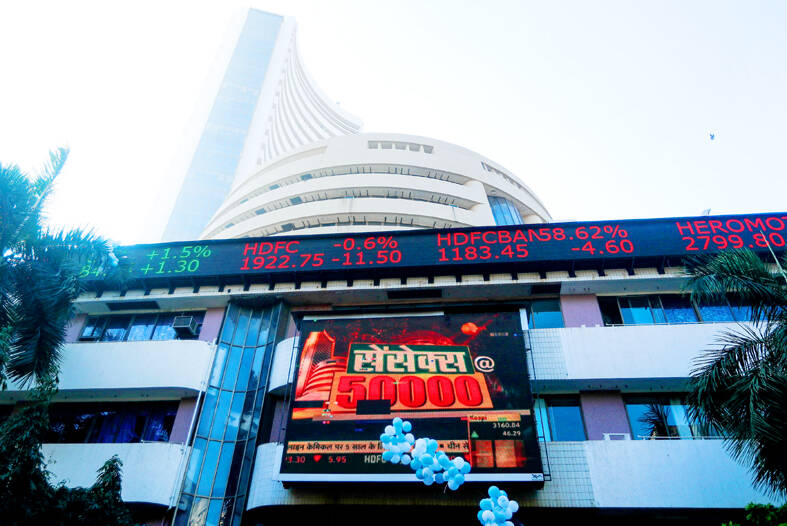Asian stock markets on Friday surged after US inflation eased more than expected, spurring hopes that the US Federal Reserve might scale down plans for more interest rate hikes.
Hong Kong’s market benchmark jumped 5.7 percent and Seoul rose 3.3 percent, while Shanghai, Tokyo and Sydney advanced.
The lower US inflation data “drove a ‘more dovish’ calibration of interest rate expectations,” IG Asia Pte market strategist Yeap Jun Rong (葉俊榮) said in a report.

Photo: REUTERS
The Fed, as well as central banks in Europe and Asia, are raising rates to cool inflation, which is at multi-decade highs. Investors worry that might tip the global economy into recession. They hope lower inflation might prompt the Fed to ease off plans for more increases.
However, forecasters on Thursday said it was too early to be certain prices are under control.
Fed officials have said rates might have to stay elevated for some time.
In Taipei, the TAIEX closed at 14,007.56 points on Friday, after soaring 503.8 points, or 3.73 percent, during the session. The index gained 980.85 points, or 7.53 percent, over the past week.
Market capitalization on the main board surged almost 7.5 percent over the past week to top NT$43 trillion (US$1.37 trillion).
Hong Kong’s Hang Seng index soared 7.74 percent to 16,994.66, up 7.21 percent from a week earlier.
The Nikkei 225 in Tokyo gained 2.9 percent to 28,229.68, up 3.91 percent on the week, while the broader TOPIX rose 2.12 percent to 1,977.76, posting a 3.26 percent weekly gain.
The Shanghai Composite Index added 1.4 percent to 3,078.42, up 0.54 percent from a week earlier.
In South Korea, the KOSPI rose 3.37 percent to 2,481.50, posting a 5.74 percent weekly gain.
India’s SENSEX rose 1.6 percent to 61,579.12, gaining 1.39 percent from a week earlier.
In Australia, the S&P/ASX gained 2.79 percent to 7,158.0, up 3.85 percent from a week earlier.
Additional reporting by staff writer

Among the rows of vibrators, rubber torsos and leather harnesses at a Chinese sex toys exhibition in Shanghai this weekend, the beginnings of an artificial intelligence (AI)-driven shift in the industry quietly pulsed. China manufactures about 70 percent of the world’s sex toys, most of it the “hardware” on display at the fair — whether that be technicolor tentacled dildos or hyper-realistic personalized silicone dolls. Yet smart toys have been rising in popularity for some time. Many major European and US brands already offer tech-enhanced products that can enable long-distance love, monitor well-being and even bring people one step closer to

Malaysia’s leader yesterday announced plans to build a massive semiconductor design park, aiming to boost the Southeast Asian nation’s role in the global chip industry. A prominent player in the semiconductor industry for decades, Malaysia accounts for an estimated 13 percent of global back-end manufacturing, according to German tech giant Bosch. Now it wants to go beyond production and emerge as a chip design powerhouse too, Malaysian Prime Minister Anwar Ibrahim said. “I am pleased to announce the largest IC (integrated circuit) Design Park in Southeast Asia, that will house world-class anchor tenants and collaborate with global companies such as Arm [Holdings PLC],”

Sales in the retail, and food and beverage sectors last month continued to rise, increasing 0.7 percent and 13.6 percent respectively from a year earlier, setting record highs for the month of March, the Ministry of Economic Affairs said yesterday. Sales in the wholesale sector also grew last month by 4.6 annually, mainly due to the business opportunities for emerging applications related to artificial intelligence (AI) and high-performance computing technologies, the ministry said in a report. The ministry forecast that retail, and food and beverage sales this month would retain their growth momentum as the former would benefit from Tomb Sweeping Day

Thousands of parents in Singapore are furious after a Cordlife Group Ltd (康盛人生集團), a major operator of cord blood banks in Asia, irreparably damaged their children’s samples through improper handling, with some now pursuing legal action. The ongoing case, one of the worst to hit the largely untested industry, has renewed concerns over companies marketing themselves to anxious parents with mostly unproven assurances. This has implications across the region, given Cordlife’s operations in Hong Kong, Macau, Indonesia, the Philippines and India. The parents paid for years to have their infants’ cord blood stored, with the understanding that the stem cells they contained